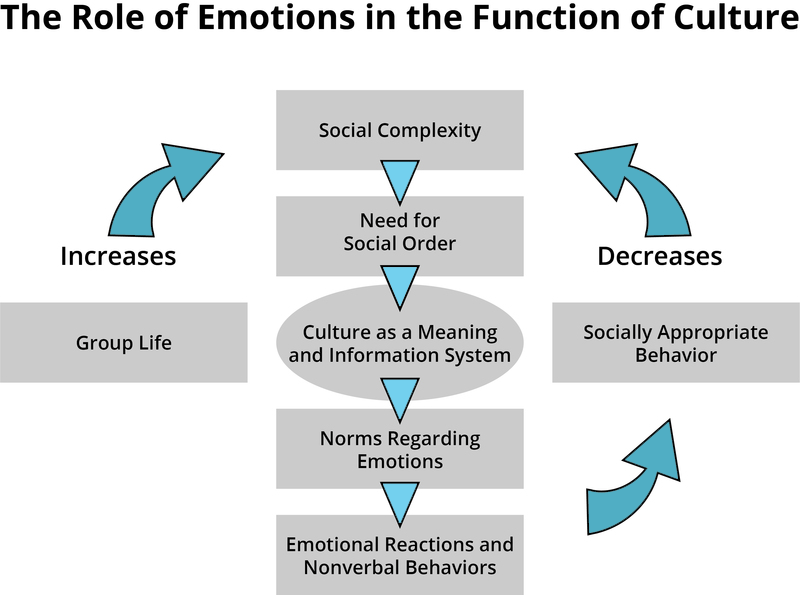3.1 Functions of Emotions

It is impossible to imagine life without emotion. We treasure our feelings—the joy at a ball game, the pleasure of the touch of a loved one, or the fun with friends on a night out. Even negative emotions are important, such as the sadness when a loved one dies, the anger when violated, the fear that overcomes us in a scary or unknown situation, or the guilt or shame toward others when our sins are made public. Emotions color life experiences and give those experiences meaning and flavor.
In fact, emotions play many important roles in people’s lives and have been the topic of scientific inquiry in psychology for well over a century (Cannon, 1927; Darwin, 1872; James, 1890). This section explores why we have emotions and why they are important. Doing so requires us to understand the function of emotions in three different contexts. The first concerns the intrapersonal functions of emotion, which refer to the role that emotions play within each of us individually. The second concerns the interpersonal functions of emotion, which refer to the role emotions play between individuals within a group. The third concerns the social and cultural functions of emotion, which refer to the role that emotions play in the maintenance of social order within a society. All in all, we will see that emotions inform us of who we are, what our relationships with others are like, and how to behave in social interactions. Emotions give meaning to events; without emotions, those events would be mere facts. Emotions help coordinate interpersonal relationships. And emotions play an important role in the cultural functioning of keeping human societies together.
In this Section
The functions of emotions can be grouped in the following ways:
1. Intrapersonal Functions of Emotion
Emotions Help us Act Quickly with Minimal Conscious Awareness
Emotions are rapid information-processing systems that help us act with minimal thinking (Tooby & Cosmides, 2008). Problems associated with birth, battle, death, and seduction have occurred throughout evolutionary history and emotions evolved to aid humans in adapting to those problems rapidly and with minimal conscious cognitive intervention. If we did not have emotions, we could not make rapid decisions concerning whether to attack, defend, flee, care for others, reject food, or approach something useful, all of which were functionally adaptive in our evolutionary history and helped us to survive. For instance, drinking spoiled milk or eating rotten eggs has negative consequences for our welfare. The emotion of disgust, however, helps us immediately take action by not ingesting them in the first place or by vomiting them out. This response is adaptive because it aids, ultimately, in our survival and allows us to act immediately without much thinking. In some instances, taking the time to sit and rationally think about what to do, calculating cost–benefit ratios in one’s mind, is a luxury that might cost one one’s life. Emotions evolved so that we can act without that depth of thinking.
Emotions Prepare the Body for Immediate Action

Emotions prepare us for behavior. When triggered, emotions orchestrate systems such as perception, attention, inference, learning, memory, goal choice, motivational priorities, physiological reactions, motor behaviors, and behavioral decision making (Cosmides & Tooby, 2000; Tooby & Cosmides, 2008). Emotions simultaneously activate certain systems and deactivate others in order to prevent the chaos of competing systems operating at the same time, allowing for coordinated responses to environmental stimuli (Levenson, 1999). For instance, when we are afraid, our bodies shut down temporarily unneeded digestive processes, resulting in saliva reduction (a dry mouth); blood flows disproportionately to the lower half of the body; the visual field expands; and air is breathed in, all preparing the body to flee. Emotions initiate a system of components that includes subjective experience, expressive behaviors, physiological reactions, action tendencies, and cognition, all for the purposes of specific actions; the term “emotion” is, in reality, a metaphor for these reactions.
One common misunderstanding many people have when thinking about emotions, however, is the belief that emotions must always directly produce action. This is not true. Emotion certainly prepares the body for action; but whether people actually engage in action is dependent on many factors, such as the context within which the emotion has occurred, the target of the emotion, the perceived consequences of one’s actions, previous experiences, and so forth (Baumeister et al., 2007; Matsumoto & Wilson, 2008). Thus, emotions are just one of many determinants of behavior, albeit an important one.
Emotions Influence Thoughts
Emotions are also connected to thoughts and memories. Memories are not just facts that are encoded in our brains; they are colored with the emotions felt at those times the facts occurred (Wang & Ross, 2007). Thus, emotions serve as the neural glue that connects those disparate facts in our minds. That is why it is easier to remember happy thoughts when happy, and angry times when angry. Emotions serve as the affective basis of many attitudes, values, and beliefs that we have about the world and the people around us; without emotions those attitudes, values, and beliefs would be just statements without meaning, and emotions give those statements meaning. Emotions influence our thinking processes, sometimes in constructive ways, sometimes not. It is difficult to think critically and clearly when we feel intense emotions, but easier when we are not overwhelmed with emotions (Matsumoto et al., 2006).
Emotions Motivate Future Behaviors
Because emotions prepare our bodies for immediate action, influence thoughts, and can be felt, they are important motivators of future behavior. Many of us strive to experience the feelings of satisfaction, joy, pride, or triumph in our accomplishments and achievements. At the same time, we also work very hard to avoid strong negative feelings; for example, once we have felt the emotion of disgust when drinking the spoiled milk, we generally work very hard to avoid having those feelings again (e.g., checking the expiration date on the label before buying the milk, smelling the milk before drinking it, watching if the milk curdles in one’s coffee before drinking it). Emotions, therefore, not only influence immediate actions but also serve as an important motivational basis for future behaviors.
2. Interpersonal Functions of Emotion

Emotions are expressed both verbally through words and nonverbally through facial expressions, voices, gestures, body postures, and movements. We are constantly expressing emotions when interacting with others, and others can reliably judge those emotional expressions (Elfenbein & Ambady, 2002; Matsumoto, 2001); thus, emotions have signal value to others and influence others and our social interactions. Emotions and their expressions communicate information to others about our feelings, intentions, relationship with the target of the emotions, and the environment. Because emotions have this communicative signal value, they help solve social problems by evoking responses from others, by signaling the nature of interpersonal relationships, and by providing incentives for desired social behavior (Keltner, 2003).
Emotional Expressions Facilitate Specific Behaviors in Perceivers
Because facial expressions of emotion are universal social signals, they contain meaning not only about the expressor’s psychological state but also about that person’s intent and subsequent behavior. This information affects what the perceiver is likely to do. People observing fearful faces, for instance, are more likely to produce approach-related behaviors, whereas people who observe angry faces are more likely to produce avoidance-related behaviors (Marsh et al., 2005). Even subliminal presentation of smiles produces increases in how much beverage people pour and consume and how much they are willing to pay for it; presentation of angry faces decreases these behaviors (Winkielman et al., 2005). Also, emotional displays evoke specific, complementary emotional responses from observers; for example, anger evokes fear in others (Dimberg & Ohman, 1996; Esteves et al., 1994), whereas distress evokes sympathy and aid (Eisenberg et al., 1989).
Emotional Expressions Signal the Nature of Interpersonal Relationships
Emotional expressions provide information about the nature of the relationships among interactants. Some of the most important and provocative set of findings in this area come from studies involving married couples (Gottman & Levenson, 1992; Gottman et al., 2001). In this research, married couples visited a laboratory after having not seen each other for 24 hours, and then engaged in intimate conversations about daily events or issues of conflict. Discrete expressions of contempt, especially by the men, and disgust, especially by the women, predicted later marital dissatisfaction and even divorce.
Emotional Expressions Provide Incentives for Desired Social Behavior
Facial expressions of emotion are important regulators of social interaction. In the developmental literature, this concept has been investigated under the concept of social referencing (Klinnert et al., 1983); that is, the process whereby infants seek out information from others to clarify a situation and then use that information to act. To date, the strongest demonstration of social referencing comes from work on the visual cliff. In the first study to investigate this concept, Campos and colleagues (Sorce et al., 1985) placed mothers on the far end of the “cliff” from the infant. Mothers first smiled to the infants and placed a toy on top the safety glass to attract them; infants invariably began crawling to their mothers. When the infants were in the center of the table, however, the mother then posed an expression of fear, sadness, anger, interest, or joy. The results were clearly different for the different faces; no infant crossed the table when the mother showed fear; only 6% did when the mother posed anger, 33% crossed when the mother posed sadness, and approximately 75% of the infants crossed when the mother posed joy or interest.
Other studies provide similar support for facial expressions as regulators of social interaction. In one study (Bradshaw, 1986), experimenters posed facial expressions of neutral, anger, or disgust toward babies as they moved toward an object and measured the amount of inhibition the babies showed in touching the object. The results for 10- and 15-month olds were the same: anger produced the greatest inhibition, followed by disgust, with neutral the least. This study was later replicated (Hertenstein & Campos, 2004) using joy and disgust expressions, altering the method so that the infants were not allowed to touch the toy (compared with a distractor object) until one hour after exposure to the expression. At 14 months of age, significantly more infants touched the toy when they saw joyful expressions, but fewer touched the toy when the infants saw disgust.
3. Social and Cultural Functions of Emotion

If you stop to think about many things we take for granted in our daily lives, we cannot help but come to the conclusion that modern human life is a colorful tapestry of many groups and individual lives woven together in a complex yet functional way. For example, when you’re hungry, you might go to the local grocery store and buy some food. Ever stop to think about how you’re able to do that? You might buy a banana that was grown in a field in southeast Asia being raised by farmers there, where they planted the tree, cared for it, and picked the fruit. They probably handed that fruit off to a distribution chain that allowed multiple people somewhere to use tools such as cranes, trucks, cargo bins, ships or airplanes (that were also created by multiple people somewhere) to bring that banana to your store. The store had people to care for that banana until you came and got it and to barter with you for it (with your money). You may have gotten to the store riding a vehicle that was produced somewhere else in the world by others, and you were probably wearing clothes produced by some other people somewhere else.
Thus, human social life is complex. Individuals are members of multiple groups, with multiple social roles, norms, and expectations, and people move rapidly in and out of the multiple groups of which they are members. Moreover, much of human social life is unique because it revolves around cities, where many people of disparate backgrounds come together. This creates the enormous potential for social chaos, which can easily occur if individuals are not coordinated well and relationships not organized systematically.
One of the important functions of culture is to provide this necessary coordination and organization. Doing so allows individuals and groups to negotiate the social complexity of human social life, thereby maintaining social order and preventing social chaos. Culture does this by providing a meaning and information system to its members, which is shared by a group and transmitted across generations, that allows the group to meet basic needs of survival, pursue happiness and well-being, and derive meaning from life (Matsumoto & Juang, 2013). Culture is what allowed the banana from southeast Asia to appear on your table.

Cultural transmission of the meaning and information system to its members is, therefore, a crucial aspect of culture. One of the ways this transmission occurs is through the development of worldviews (including attitudes, values, beliefs, and norms) related to emotions (Matsumoto & Hwang, 2013; Matsumoto et al., 2008). Worldviews related to emotions provide guidelines for desirable emotions that facilitate norms for regulating individual behaviors and interpersonal relationships. Our cultural backgrounds tell us which emotions are ideal to have, and which are not (Tsai et al., 2006). The cultural transmission of information related to emotions occurs in many ways, from childrearers to children, as well as from the cultural products available in our world, such as books, movies, ads, and the like (Schönpflug, 2009; Tsai et al., 2007).

Cultures also inform us about what to do with our emotions—that is, how to manage or modify them—when we experience them. One of the ways in which this is done is through the management of our emotional expressions through cultural display rules (Friesen, 1972). These are rules that are learned early in life that specify the management and modification of our emotional expressions according to social circumstances. Thus, we learn that “big boys don’t cry” or to laugh at the boss’s jokes even though they’re not funny. By affecting how individuals express their emotions, culture also influences how people experience them as well.
Because one of the major functions of culture is to maintain social order in order to ensure group efficiency and thus survival, cultures create worldviews, rules, guidelines, and norms concerning emotions because emotions have important intra- and interpersonal functions, as described above, and are important motivators of behavior. Norms concerning emotion and its regulation in all cultures serve the purpose of maintaining social order. Cultural worldviews and norms help us manage and modify our emotional reactions (and thus behaviors) by helping us to have certain kinds of emotional experiences in the first place and by managing our reactions and subsequent behaviors once we have them. By doing so, our culturally moderated emotions can help us engage in socially appropriate behaviors, as defined by our cultures, and thus reduce social complexity and increase social order, avoiding social chaos. All of this allows us to live relatively harmonious and constructive lives in groups. If cultural worldviews and norms about emotions did not exist, people would just run amok having all kinds of emotional experiences, expressing their emotions and then behaving in all sorts of unpredictable and potentially harmful ways. If that were the case, it would be very difficult for groups and societies to function effectively, and even for humans to survive as a species, if emotions were not regulated in culturally defined ways for the common, social good. Thus, emotions play a critical role in the successful functioning of any society and culture.
 Learn More About This Topic
Learn More About This Topic
Additional Resources
- Alberta, G. M., Rieckmann, T. R., & Rush, J. D. (2000). Issues and recommendations for teaching an ethnic/culture-based course. Teaching of Psychology, 27, 102-107. doi:10.1207/S15328023TOP2702_05
http://top.sagepub.com/content/27/2/102.short - CrashCourse (2014, August 4). Feeling all the feels: Crash course psychology #25. [Video]. YouTube. https://youtu.be/gAMbkJk6gnE
- Hughesm A. (2011). Exercises and demonstrations to promote student engagement in motivation and courses. In R. Miller, E. Balcetis, S. Burns, D. Daniel, B. Saville, & W. Woody (Eds.), Promoting student engagement: Volume 2: Activities, exercises and demonstrations for psychology courses (pp. 79-82) Society for the Teaching of Psychology, American Psychological Association. http://teachpsych.org/ebooks/pse2011/vol2/index.php
- Johnston, E., & Olson, L. (2015). The feeling brain: The biology and psychology of emotions. W.W. Norton & Company. http://books.wwnorton.com/books/The-Feeling-Brain/
- Hamilton, J., & Ulady, N. (2015, June 13). Science of sadness and joy: ‘Inside Out’ gets childhood emotions right. NPR News. http://www.npr.org/sections/health-shots/2015/06/13/413980258/science-of-sadness-and-joy-inside-out-gets-childhood-emotions-right
 Exercises
Exercises
Discussion Questions
- When emotions occur, why do they simultaneously activate certain physiological and psychological systems in the body and deactivate others?
- Why is it difficult for people to act rationally and think happy thoughts when they are angry? Conversely, why is it difficult to remember sad memories or have sad thoughts when people are happy?
- You’re walking down a deserted street when you come across a stranger who looks scared. What would you say? What would you do? Why?
- You’re walking down a deserted street when you come across a stranger who looks angry. What would you say? What would you do? Why?
- Think about the messages children receive from their environment (such as from parents, mass media, the Internet, Hollywood movies, billboards, and storybooks). In what ways do these messages influence the kinds of emotions that children should and should not feel?
References
The section has been adapted from:
Functions of Emotions by Hyisung Hwang and David Matsumoto and is licensed under a Creative Commons Attribution-NonCommercial-ShareAlike 4.0 International License, except where otherwise noted.
Baumeister, R. F., Vohs, K. D., DeWall, N., & Zhang, L. (2007). How emotion shapes behavior: Feedback, anticipation, and reflection, rather than direct causation. Personality and Social Psychology Review, 11(2), 167–203.
Bradshaw, D. (1986). Immediate and prolonged effectiveness of negative emotion expressions in inhibiting infants’ actions (Unpublished doctoral dissertation). University of California, Berkeley.
Cannon, W. B. (1927). The James–Lange theory of emotions: A critical examination and an alternative theory. American Journal of Psychology, 39, 106–124.
Cosmides, L., & Tooby, J. (2000). Evolutionary psychology and the emotions. In M. Lewis & J. M. Haviland-Jones (Eds.), Handbook of emotions (2nd ed., pp. 91–115). Guilford Press.
Darwin, C. (1872). The expression of emotion in man and animals. Oxford University Press.
Dimberg, U., & Ohman, A. (1996). Behold the wrath: Psychophysiological responses to facial stimuli. Motivation & Emotion, 20(2), 149–182.
Eisenberg, N., Fabes, R. A., Miller, P. A., Fultz, J., Shell, R., Mathy, R. M., & Reno, R. R. (1989). Relation of sympathy and distress to prosocial behavior: A multimethod study. Journal of Personality and Social Psychology, 57, 55–66.
Elfenbein, H. A., & Ambady, N. (2002). On the universality and cultural specificity of emotion recognition: A meta-analysis. Psychological Bulletin, 128(2), 205–235.
Esteves, F., Dimberg, U., & Ohman, A. (1994). Automatically elicited fear: Conditioned skin conductance responses to masked facial expressions. Cognition and Emotion, 8(5), 393–413.
Friesen, W. V. (1972). Cultural differences in facial expressions in a social situation: An experimental test of the concept of display rules (Unpublished doctoral dissertation). University of California, San Francisco.
Gottman, J. M., & Levenson, R. W. (1992). Marital processes predictive of later dissolution: Behavior, physiology, and health. Journal of Personality and Social Psychology, 63(2), 221–223.
Gottman, J. M., Levenson, R. W., & Woodin, E. (2001). Facial expressions during marital conflict. Journal of Family Communication, 1, 37–57.
Hertenstein, M. J., & Campos, J. J. (2004). The retention effects of an adult’s emotional displays on infant behavior. Child Development, 75(2), 595–613.
James, W. (1890). The principles of psychology. Holt.
Keltner, D. (2003). Expression and the course of life: Studies of emotion, personality, and psychopathology from a social-functional perspective. In P. Ekman, J. Campos, R. J. Davidson, & F.B.M. De Waal (Eds.), Emotions inside out: 130 years after Darwin’s “The expression of the emotions in man and animals” (Vol. 1000, pp. 222–243). New York Academy of Sciences.
Klinnert, M. D., Campos, J. J., & Sorce, J. F. (1983). Emotions as behavior regulators: Social referencing in infancy. In R. Plutchik & H. Kellerman (Eds.), Emotion: Theory, research, and experience (pp. 57–86). Academic Press.
Levenson, R. W. (1999). The intrapersonal functions of emotion. Cognition and Emotion, 13(5), 481–504.
Marsh, A. A., Ambady, N., & Kleck, R. E. (2005). The effects of fear and anger facial expressions on approach- and avoidance-related behaviors. Emotion, 5(1), 119–124.
Matsumoto, D. (2001). Culture and emotion. In D. Matsumoto (Ed.), The handbook of culture and psychology (pp. 171–194). Oxford University Press.
Matsumoto, D., & Hwang, H. C. (2013). Assessing cross-cultural competence: A review of available tests. Journal of Cross-Cultural Psychology, 44(6), 849–873.
Matsumoto, D., & Juang, L. (2013). Culture and psychology (5th ed.). Cengage.
Matsumoto, D., & Wilson, J. (2008). Culture, emotion, and motivation. In R. M. Sorrentino & S. Yamaguchi (Eds.), Handbook of motivation and cognition across cultures (pp. 541–563). Elsevier.
Matsumoto, D., Hirayama, S., & LeRoux, J. A. (2006). Psychological skills related to adjustment. In P.T.P. Wong & L.C.J. Wong (Eds.), Handbook of multicultural perspectives on stress and coping (pp. 387–405). Springer.
Matsumoto, D., Yoo, S. H., Nakagawa, S., Alexandre, J., Altarriba, J., Anguas-Wong, A. M., et al. (2008). Culture, emotion regulation, and adjustment. Journal of Personality and Social Psychology, 94(6), 925–937.
Schönpflug, U. (Ed.). (2009). Cultural transmission: Developmental, psychological, social and methodological aspects. Cambridge University Press.
Sorce, J. F., Emde, J. J., Campos, J. J., & Klinnert, M. D. (1985). Maternal emotional signaling: Its effect on the visual cliff behavior of 1-year-olds. Developmental Psychology, 21, 195–200.
Tooby, J., & Cosmides, L. (2008). The evolutionary psychology of the emotions and their relationship to internal regulatory variables. In M. Lewis, J. M. Haviland-Jones, & L. Feldman Barrett (Eds.), Handbook of emotions (3rd ed., pp. 114–137). The Guilford Press.
Tsai, J. L., Knutson, B., & Fung, H. H. (2006). Cultural variation in affect valuation. Journal of Personality and Social Psychology, 90(2), 288–307.
Tsai, J. L., Louie, J. Y., Chen, E. E., & Uchida, Y. (2007). Learning what feelings to desire: Socialization of ideal affect through children’s storybooks. Personality and Social Psychology Bulletin, 33(1), 17–30.
Wang, Q., & Ross, M. (2007). Culture and memory. In S. Kitayama & D. Cohen (Eds.), Handbook of cultural psychology (pp. 645–667). Guilford.
Winkielman, P., Berridge, K. C., & Wilbarger, J. L. (2005). Unconscious affective reactions to masked happy versus angry faces influence consumption behavior and judgments of value. Personality and Social Psychology Bulletin, 31(1), 121–135.

